Management Consultancy Report Submission for Medical Business
Info: 8157 words (33 pages) Dissertation
Published: 10th Dec 2019
Tagged: ManagementBusiness Analysis
Management Consultancy Report Submission
Table of Contents
Section I: Industry and Organisational Drivers of Project Management
Section II: Alignment with Strategy
Section III: Project Lifecycle
Section IV: Organisational Structure
Section V: Project and Organisational Maturity
Section VI: People and Competency Development
Section VII: Stakeholder Analysis
Executive Summary
This report presents an analysis of the New Product Introduction (NPI) Project Management capabilities in ProTek Medical. The analysis covers a review of the main drivers behind NPI Project Management Process in ProTek Medical, the alignment of the process to the company strategy, a review of the current project lifecycle, the structure of the project organisation, the maturity of the project management systems, the competency and development process of the project management personnel and an analysis of the current stakeholder identification and management processes.
The report is based on the author’s personal view of the project management practices but also draws on input from the primary Project Management professionals in the NPI team, gathered via questionnaires.
This review identified a number of deficiencies in almost each area examined and includes recommendations to address these deficiencies. The most notable issues identified included:
- Competency Development
Of the five (5) project personnel responsible for the management of projects in ProTek Medical none have received any significant training in Project Management to date but have acquired their knowledge through on the job learning.
Additionally there is no competency development process in place in ProTek Medical to develop the skills and capabilities of the project management personnel.
This report includes a number of recommendations to increase the competency of the project management personnel and to put in place a process for competency development.
- Maturity of the Project Management Systems
Utilizing the P3M3 Self-Assessment for Projects the maturity of the project management system was assessed to be a Level 2. This is deemed by the author to be insufficient and it is recommended to develop a plan to improve the overall maturity of the project management process.
- Stakeholder Management
Currently in ProTek Medical there is no formal system for stakeholder mapping or management. Given that the majority of high value projects undertaken by the project management team as for external customers this is seen as a significant deficiency and it is recommended to develop a system to ensure stakeholders are identified and managed in a more consistent way.
- Project Lifecycle
The scope of the project lifecycle is very limited and is focussed on getting projects “over the line” and contains a number of very obvious gaps such as benefits identification & realisation; stakeholder analysis…
Introduction
ProTek Medical (ProTek, PTM) is currently undergoing significant organisational and strategic change. ProTek Medical was acquired in June 2015 by Molex LLC (Molex), owned by Koch Industries (Koch) and has been undergoing integration into both Molex and Koch Industries since that time. In late-2016 Molex acquired Phillips-Medisize Corporation (Phillips-Medisize, PMC). As a result of this acquisition and the relative size of the Phillips-Medisize organisation, Phillips-Medisize became the Medical and Pharmaceutical Solutions Division of Molex with ProTek Medical reporting directly to Phillips-Medisize, US. The integration process has therefore changed to align ProTek Medical with Phillips-Medisize.
The introduction of new products into ProTek manufacturing is project managed by the New Product Introduction Department. The team is comprised of four Project Managers and additional support staff but also draws on specialised resources from the wider Functional Areas. Other common projects in ProTek, such as Continuous Improvement Projects are typically managed at a functional level but are outside the scope of this assessment.
This report is therefore based on the current NPI systems and processes within ProTek Medical taking into account the ongoing changes due to the integration process. Where Phillips-Medisize or Molex systems or processes are referenced these will be explicitly identified.

Image 1: Recent history of ProTek Medical’s position with respect to the acquisitions by Molex LLC.
Koch Industries, Inc. is a privately owner, multinational corporation with more than 120,000 employees in 60 countries and subsidiaries across a number of industry sectors including manufacturing, ranching and medical technology.
Molex LLC is a world leading manufacturer of electrical and fiber optic interconnection systems with products across a number of industries such as aerospace, defence, automotive, computing and medical.
Phillips-Medisize Corporation is a global leader in outsource design, development and technology-driven manufacturing for a variety of industries including automotive, defence and medical technology.
ProTek Medical is a 100% medical focussed contract manufacturer, specialising in manufacturing and assembly of custom products for Medical Device OEMs worldwide.
Section I: Industry and Organisational Drivers of Project Management
Industry & Organisational Drivers
ProTek Medical, being a medical device contractor and service provider, relies on a pipeline of New Product Introduction projects to maintain the viability of the business. Many of the products manufactured by ProTek have limited lifecycles, often reaching end of life within 5-10 years of launch. To continue to grow the business it is important that ProTek continues to develop and win new opportunities. Key to this is the effective performance of the NPI process which helps drive the company strategy in a competitive environment.
Drawing on the Seven Forces Model of Project Management (Turner 2007) the key drivers influencing the management of ProTek projects could be said to be:
- The customer who finances the projects, expects to achieve the defined benefits and who drives the urgency of the project.
- The competitive environment in which ProTek operates, with the need to provide superior value to its Competitors particularly in terms of Cost, Quality and Delivery or Service.
- The organisational governance which aligns ProTek’s projects with the Organisation’s strategy.
- The governance of the Regulatory and other Bodies ensuring compliance to ISO 13485, other relevant standards and ProTek’s own Quality Management System.
Additionally there are internal drivers which influence projects to a lesser degree such as the knowledge and skills of the project team members, leadership, technical capabilities and the Organisation’s systems and processes to name just a few.
Relative Priority of the PMBOK® Knowledge Areas
The ten PMBOK® Knowledge Areas, per the PMI Project Management Body of Knowledge 6th Edition, were reviewed and reflected upon by the Author to identify the relative priority placed on them in the Organisation. Additionally, the ProTek project management team were polled to provide further data for comparison.
To assess the relative priority of each Knowledge Area, following the review of the knowledge areas subjective scores out of ten were given to each knowledge area with the results tabulated in Table 1 below. The scoring, though subjective, is intended to aid in identifying the knowledge areas which receive the greatest attention within a typical NPI project in the Organisation. The author’s assessment and scoring rationale is attached in the Appendix.
Note: The Project Management team members polled have not received any formal training on the knowledge areas to date. This lack of familiarity resulted in a very wide variation in poll results rendering the data unreliable for this assessment.
| Knowledge Areas | Author
Score (/10) |
Poll AVG
Score (/10) |
|
| 1 | Project Integration Management | 8 | 5 |
| 2 | Project Scope Management | 4 | 4 |
| 3 | Project Schedule Management | 7 | 6 |
| 4 | Project Cost Management | 5 | 4 |
| 5 | Project Quality Management | 4 | 6 |
| 6 | Project Resource Management | 4 | 4 |
| 7 | Project Communications Management | 8 | 6 |
| 8 | Project Risk Management | 4 | 4 |
| 9 | Project Procurement Management | 7 | 4 |
| 10 | Project Stakeholder Management | 6 | 5 |
Table 1: Results of the assessment of the relative priority of the PMBOK® Knowledge Areas in ProTek Medical
Using this methodology the following knowledge areas scored highest by the author in terms of relative priority:
- Project Integration Management
- Project Schedule Management
- Project Communication Management
- Project Procurement Management
It would seem natural, given that the primary driver influencing projects in ProTek Medical is the primary stakeholder and sponsor, the external Customer, that the Knowledge Areas given the most priority in the Organisation are those concerned primarily with:
- Coordination, monitoring and control of project activities (Project Integration Management)
- Ensuring all project activities are detailed, planned, resourced and understood by project team members (Project Schedule Management & Communication Management)
- Ensuring the Customer, Management and other key stakeholders are updated on project status (Project Communication Management)
- Ensuring that all relevant project information is disseminated to the project team to allow them to fulfil their required project activities (Project Communication Management)
- Ensuring that communications to the Customer, project team and Executive Management and planned and controlled as required (Project Communication Management)
- Ensuring one of the key stakeholders, the tooling vendor, is carefully managed. (Project Procurement Management)
It should be noted however that as ProTek’s business is contract manufacturing and service provision, the scope of NPI projects can vary considerably and therefore the relative priorities of the knowledge areas can also change from project to project.
One key observation of this assessment is the low priority given to important Knowledge Areas such as Scope Management, Quality Management and Risk Management, especially given the nature of our business. Though it is acknowledged that “most project managers often have limited time to perform all that is required by the PMBOK® Guide” (Zwikael 2009) it would be my recommendation that:
- Project Managers receive coaching on the PMBOK® knowledge areas to understand the potential influence each knowledge area has on the successful delivery of the project and to be able to assess which knowledge areas to focus on for a particular project.
- Particular focus should be paid to Time, Risk, Scope, and Human Resources as these knowledge areas most influence project success results and are the most critical knowledge areas to focus on during the planning process (Zwikael 2009).
- A review of the planning process to understand how more time could be allocated to focus on those knowledge areas which receive little attention at present.
- Our Project Management procedures should be updated to include information on these knowledge areas.
- Support and/or tools to aid the project manager in adding more focus to Scope, Quality and Risk Management activities.
Additional Area of Focus
It should be noted that the PMBOK® has been criticised for being limited in scope (Morris et al 2006). Based on how projects are managed in our organisation and the relative priority placed on the various knowledge areas I would recommend further review be carried into the following area:
- Benefits identification and realisation. Consideration should be given to what happens following project closure and should the current lifecycle be extended to ascertain whether planned benefits have been adequately realised. This aligns with gaps identified between the current ProTek lifecycle and the Molex PDP; this is further reviewed in Section Three.
Section II: Alignment with Strategy
Strategy Alignment
To consider how project selection aligns with strategy we need to consider the corporate vision which is to:
“Become the leading global design and contract manufacturer to the healthcare and specialty commercial markets by establishing OEM partnerships built on innovation, quality and service”
Strategically this means we continue to focus on our core growth markets of Biopharma drug delivery, consumable diagnostics and medical devices that are benefiting from strong, positive growth trends. The Organisation’s project selection process is primarily opportunity driven however this is guided by focussing on delivering for our existing customers and developing core capabilities to match the target markets of drug delivery, diagnostics and medical device manufacturing, while selling our global presence to new customers through local service and support.
The strategy at a site level is more execution focussed and is defined as four main actions:
- Drive profitable growth
- Operate Cost effectively
- Enhance culture and capability
- Drive Customer focus
When translated to a functional level, implementing this strategy requires:
- Partnering with our Sales & Marketing organisation to promote our capabilities.
- Being flexible, adaptable and long term focussed, ready to take advantage of emerging trends and opportunities.
- Driving a culture of innovation and principled entrepreneurship within a lean organisation.
- Driving a quality and risk focussed, right first time mentality through project management.
- Maintaining a global mind-set to promote the network of capabilities throughout our organisation.
- Encouraging a culture of knowledge sharing and total involvement.
- Forging strong customer relationships to anticipate Customer’s future needs.
- Seamless execution of projects from NPI through to Manufacturing.
The site level strategy would seem to take it for granted that we are doing the right types of projects as we continue to develop customers within the target markets. On certain low value projects we often have to consider if there is a sufficient return on investment taking on the project or assessing the pay-back period should the project requite capital investment. However the decision to support these projects is often based on the strategic importance of the customer rather than the financial benefit to the organisation.
Portfolio Selection
One of the significant changes resulting from the integration process with Phillips-Medisize is that project selection for our site is primarily defined outside of the immediate organisation. At a global ‘Opportunity Development’ level new opportunities are assessed and the most appropriate design or manufacturing site for the project is selected. The project selection process involves a number of stakeholders including Site Leadership, Sales or Business Development and Corporate Opportunity Development and would appear to be more interested in where to place the project than whether or not the project is taken on. This is with the exception of projects from start-ups or other high risk ventures which are identified during the screen process. An excel based tool is used to assess the company risk in these situations.
The methodology for site selection is somewhat unclear but will often follow historical or geographic lines but additionally it may depend on factors such as project requirements, technological capabilities or resource availability for example.
Attempting to match the process to the model proposed by N P Archer and F Ghasemzadeh, the process may look something like that in image X below. It should be highlighted however that the author is not familiar with all the detail of the selection and screening process.
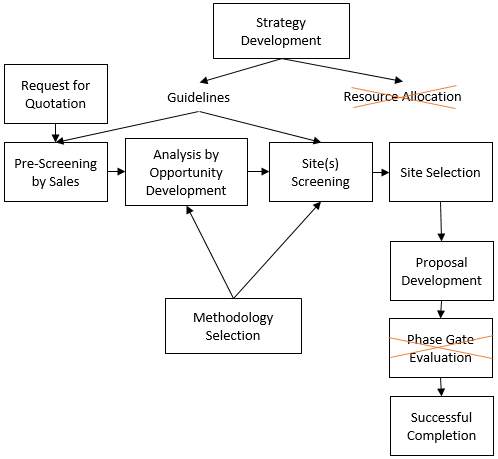
Image X: Portfolio Selection Process
Recommendations
It is the author’s opinion that our portfolio of NPI projects aligns well with our site strategy and the corporate strategy of ‘become a leading contract manufacturer to the healthcare market’.
To ensure we continue to take on and manage the right projects it may be beneficial to conduct a periodic analysis of the portfolio of projects at a site level to ensure that all projects continue to be aligned with the Organisation’s objectives. Such a Project Portfolio Management process could also provide benefit in that:
- It can provide an overview for site Management of all active projects
- It provides a method for identification and prioritisation of projects.
- It aids in the control of low value projects.
- Resource utilization and allocation per project can be analysed and optimised
As the integration process is on ongoing process I will not provide any recommendations with respect to the portfolio selection process at a Corporate level as the current process and methodology is still somewhat unclear at the present time.
Section III: Project Lifecycle
ProTek Medical Project Lifecycle
Currently the NPI process in ProTek Medical is documented in a Guidance Document (GD 001 New Product Introduction QMS Guidance Document Rev 000) which details a prescriptive process through which new projects are introduced into ProTek Medical Production. The “NPI” process can be considered analogous to the project lifecycle in ProTek though the process as documented in GD001 does not describe the typical lifecycle phases of projects but rather the primary tasks which must be accomplished.
It should also be highlighted that there was an ongoing process in ProTek to adopt the Molex Product Development Process (PDP) which is an overall Product Lifecycle Framework in operation throughout Molex sites worldwide. This integration process has now been halted though the current ProTek process does reflect a small degree of alignment with the Molex PDP.
The Image X below represents the current project lifecycle of a typical project in ProTek Medical.
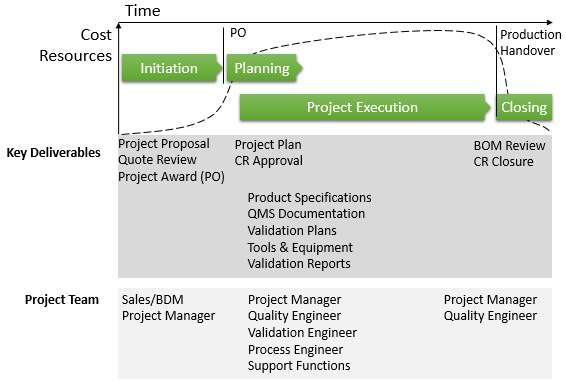
Image X: Project Lifecycle of a typical project in ProTek Medical
A typical project in ProTek Medical can be seen to follow four general phases.
- Project Initiation involves reviewing Customer Request for Quotations (RFQs); part and equipment price calculations and generation of a project proposal. Following project award the receipt of a customer PO is the initiator to enter the planning and execution phases of projects.
- Project Planning involves the initiation of the project from the Quality Management Systems point of view with the opening of a formal Change Request by the NPI Department. This phase also typically involves generation of a project timeline or other project status file used to document and track the key project milestones. It should be noted that there is a significant time overlap between project planning and project execution with minimal time available for a distinct project planning phase before execution begins.
- Project Execution is where the main body of work on a project occurs and typically will involve:
- Sourcing of raw materials or purchased components
- Purchase, manufacture and debug of tooling, automation, fixturing and other equipment
- Development & qualification of the manufacturing processes
- Completion and delivery of the qualification pack(s) to the customer
- Customer approval
- Closing is the informal handover to Production of all processes qualified during the Execution phase of the project. Product BOMs are typically reviewed for accuracy and the Quality Management activities are formally closed with completion and approval of the Change Request Form Appendix.
The current project lifecycle aligns with the Molex Product Development Process as shown in the graphic below. A more detailed overview of the Molex PDP is included in the Appendix.
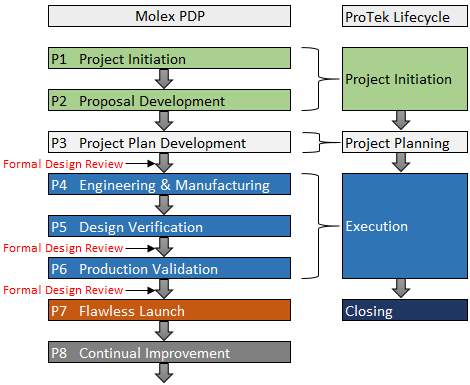
Image X: Comparison of Molex PDP vs ProTek Medical Lifecycle
Appropriateness of the Current Project Lifecycle
On review of the current ProTek project lifecycle in Image X it is observed that it follows a very typical flow common to many projects and to examples found in literature. Taking a critical view of the process we observe the following:
- Little time is allocated for project planning prior to project execution. These activities almost occur in parallel. The need for an effective planning process is crucial to the success of a project as has been well documented in research literature.
- There are no formal stage gate reviews, even following completion of qualifications and prior to handover to production. It is acknowledged however that implementation of stage gates are already under review in ProTek and planned to be implemented in future updates to the NPI process.
- Noting the difference between a “Product Life Cycle” and a “Project Life cycle” (Turner 200X), there may be benefit in broadening the scope of the project lifecycle to also include implementation of the products; similar to the extended lifecycle of the APM BOK. Further alignment to at least the “Flawless Launch” phase of the Molex PDP Frame work may be sufficient to ensure the products are supported during launch and that the benefits identified at the outset are assessed.
- The Close out phase does not include any ‘lessons learned’ or other performance assessment or analysis tools.
The current lifecycle is primarily being driven by:
- The customer who drives the urgency of the project. A PO is issued on project award and starts the planning and execution phases of the project. Tooling delivery times (typically on the critical path) are based on receipt of POs, allowing minimal time for planning before the tooling is expected to kick off. The ‘clock is ticking’ once the PO has been received.
- The need to ensure we have a formal project award before applying engineering time to the project i.e. no advance planning or risk assessment activities are to be completed, except at a very top level as part of the proposal process.
- The need to close out projects quickly to release resources for the next project. Typically each project team member is involved with multiple projects at various stages of their lifecycles. Too often project closure is rushed or incomplete once processes are qualified and have been transferred to production.
- A lack of maturity of the project management systems, competence of the leadership in terms of knowledge of project management processes.
Recommendations
Based on a review of the current project life cycle I believe implementing the following changes would yield positive changes:
- Consideration should be given to extension of the current project life cycle to ensure a “flawless launch” and assessment of realised benefits. This is likely to consume more resources for short period of time but should yield positive benefits for the organisation.
- Stage gates should be implemented in at least two points; before qualification activities and as part of a formal handover to Production. This should be reviewed further against the PMBOK® and the Molex PDP Framework.
- Additional time must be giving to project planning and risk management activities. Perhaps quoted timelines can be reviewed to allow additional time for these activities.
- Project performance must be assessed either via implementation of Lessons Learned or alternative methodology.
- Further recommendations relating to Project Management Maturity and Competence are covered in Section 5 of this report.
Section IV: Organisational Structure
Organisational Structure
The ProTek project organisational structure was examined with consideration to the primary types of organisational models; functional, matrix and projectized as per PMBOK® (PMI 2017).
The ProTek organisational structure for NPI projects is a Matrix structure; it shares aspects of both a Balanced Matrix structure and a Strong Matrix structure. Although the Project Manager controls most of the aspects of the project and has the greater balance of authority over the project, she(he) does not always have final say over major project decisions and she(he) is not always responsible for assignment of functional personnel.

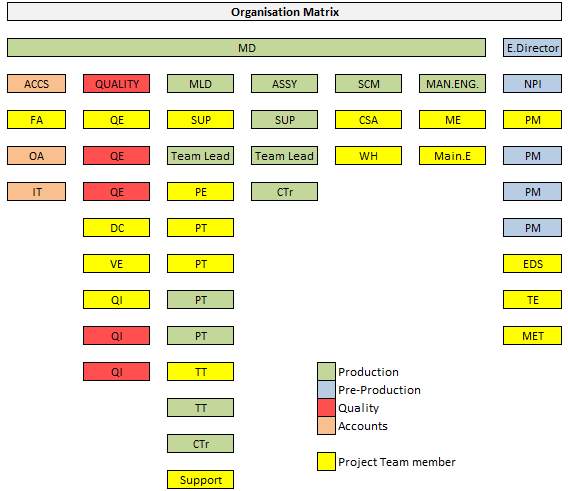
Image 1: Matrix Project Structure in operation in ProTek Medical.
The organisational structure is shown in Image x; the chart is colour coded to show how personnel from various functional areas form the typical project team; abbreviations (TE, PM, QE) indicate the various job functions. The Project Manager resides in the NPI team with additional support staff though the primary subject matter experts and functional supports reside in the other Functional Areas of the organisation particularly in Operations (Moulding, Assembly and Manufacturing Engineering) and Quality.
A Project Status File & RACI Matrix is included in the Appendix; this further demonstrates the cross functional assignment of responsibilities on a typical NPI project.
| Project Requirements | ||||||
| Deliverable | N/A Where applicable. | RESPONSIBLE | ACCOUNTABLE | CONSULTED | INFORMED | |
| Project Kick Off / Stakeholder Review | -Select- | PM | EMGR | CFT | CFT | |
| Product Codes for Sub-Assy | -Select- | EDS | PM | QE | CFT | |
| Product Codes for Finished Good | -Select- | EDS | PM | QE | CFT | |
| BOM | -Select- | EDS/PM | PM | QE | CFT | |
Table X: Four (4) line example from Project Status File & RACI Matrix
Advantages & Disadvantages of the ProTek Project Organisation Structure
In my assessment the Matrix structure is the correct organisational structure for NPI projects in ProTek Medical. This structure offers a number of advantages:
- Though we have a high percentage of projects in ProTek which may call for a fully projectized structure the Matrix approach is more cost effective. A typical project requires subject matter expertise across a number of functional areas which we could not afford to dedicate solely to NPI projects.
- This approach offers dual project-functional focus. It would be normal that a Quality Engineer, for example, divide their time between supporting NPI projects and ongoing production activities which is advantageous where neither activity requires a full time Quality Engineer.
- The involvement of Functional Area owners is maintained; this is advantageous where their experience and expertise may be beneficial for key decision making and for resource management.
- Development and maintenance of technical competency in a specialist fields is facilitated when specialists are grouped in the same department (Hobbs & Menard 1993).
This is especially true of our Moulding Processing Personnel which is a specialised function.
- Clear communication channel to the Customer and primary stakeholders via the Project Manager.
- The makeup of a project team i.e. the skill sets or subject matter experts required, may vary as the project progresses through its lifecycle which can be facilitated by this Matrix structure.
- This approach offers flexibility and more efficient resource utilization. Functional area owners can assign different subject matter experts at different phases in a project depending on their own workload, capacity and priority.
- This approach is also better suited to the typical sizes of projects in ProTek which may only require a small percentage of scarce resources at any given time.
- Team members remain in their natural home, can knowledge share among their peers and leverage support or expertise from their Functional team members.
We have, however, experienced a number of challenges with this structure on projects to date, for example:
- Priorities in other functional areas can change limiting access to required resources.
- With changing priorities and varying workloads, this can lead to inter-function conflict and stresses.
- Decision making can be more challenging as difficult decisions are often handled outside the immediate project team and may require escalation to Functional owners or Senior Management.
- Project progress can therefore sometimes be slower when compared to a projectized structure.
- Functional team members can sometimes be ‘tribal’ and not gel as a project team, resulting in significant challenges for the Project Manager to overcome.
- Task ownership, when not clearly defined, can sometimes be pushed between Functional areas leading to further conflict and project delays.
- Projects may be more time/cost focussed at the expense of quality, when compared to projects organised via a Functional structure.
- Utilization of “rare” resources can be challenging particularly where Functional Area Owners place more priority on their own activities ahead of project activities.
Recommendations
Despite the issues identified above the Matrix structure is the optimum structure for typical projects in ProTek as it balances the needs of both the organisation and the project in terms of allocation of resources, decision rights and access to expertise across the organisation, for example. I would not recommend a change of organisational structure at this point in time.
However, it is important the Organisation is aware of the alternatives configurations for project organisations and the benefits thereof and I would recommend that some consideration is given to the optimum structure in situations where a project may be regarded as atypical. Based on a number of factors, such the size of the organisation, the availability of scarce resources, the size and type of typical projects and the strategic importance of projects to the organisation it may be advisable to alter the organisational structure on a given project should this need arise. The assessment model in Table X can be used to aid the decision making process.
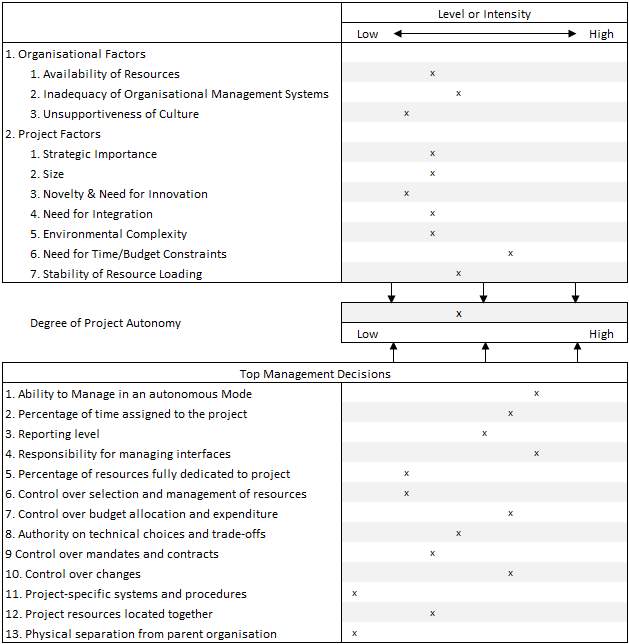
Table X: Hobbs & Menard Model assessment of a typical ProTek project indicating a medium degree of project autonomy required.
Section V: Project and Organisational Maturity
Organisational Maturity
Using the P3M3® Project Management Self-Assessment the current level of organisational maturity in respect of project management in our organisation was assessed by the author. The result obtained was an overall maturity rating of Level 2. The results for each individual assessment question is indicated in the graphic below.
As there may be potential for optimism bias in this result an assessment with the wider project management team was conducted and this assessment also yielded an overall maturity result of Level 2.

Image X: Result of P3M3 Maturity Assessment for ProTek Medical (conducted by author)
Appropriate Level of Maturity
Project Management in ProTek Medical is of strategic importance to the organisation. The company is fully dependent on the NPI team for the design transfer of products into manufacturing. The relationships developed between the NPI team and the Organisation’s customers and the effectiveness of the NPI process are crucial to securing repeat business from customers and for ensuring expected benefits are realised by the organisation.
Improving the maturity of the project management systems should be seen as an important step in improving the overall performance of the NPI process. Research has also shown that “with higher project maturity, organizations can achieve substantial savings, increase sales growth, show better competitive-ness compared with their competitors, and establish best practices in their industry or service sector” (Yazici 2009).
Additionally, as a contract manufacturer of medical device components it is important we have robust systems in place to help us drive a culture focussed on quality and compliance with a right first time mentality.
It is my belief, therefore, that a minimum of Level 3 is required for our organisation for the reasons outlined. I recommend we strive for a Level 4 maturity in Management Control so we can continue to measure, analyse and improve our project management performance.
I would also recommend setting a stretch goal of Level 4 overall maturity, to be reassessed at a future date depending on the strategic needs of the organisation.
| Current | Future State | Stretch Goal | |||
| Management Control |
|
4 |  4 4 |
||
| Benefits Management | 2 | 3 |  4 4 |
||
| Financial Management | 3 | 3 |  4 4 |
||
| Stakeholder Engagement | 2 | 3 |  4 4 |
||
| Risk Management | 2 | 3 |  4 4 |
||
| Organizational Governance | 3 | 3 |  4 4 |
||
| Resource Management | 3 |
|
 4 4 |
Table X: Current state, recommended future state and stretch goal for Project Management Maturity in ProTek Medical.
Achieving the Future State
Achieving a future state of Level 3 maturity is a reasonable expectation. Once we can define ‘what good looks like’ we can define the actions required and a strategy for implementation, particularly focussed on the four knowledge areas which were identified as requiring improvement:
- Management Control:
- Benefits Management:
- Stakeholder Management
- Risk Management
Some key points of this plan can include:
- The identification of relevant KPIs will aid in measuring, analysing and driving performance improvements.
- The implementation of project management systems and process for the management of all change activities within in the wider organisation.
- The implementation of mechanisms for defining and tracking project benefits.
- The development of new processes and tools to facilitate improvements to Stakeholder Management.
- Leveraging our knowledge of the Risk Management Standard ISO14971 and utilizing subject matter experts in the Quality Functional Area to assist with developing an improvement plan.
- Leveraging the expertise in the Corporate PMO for guidance.
Achieving a higher level of maturity, particularly if we aim for the stretch goal in any of the knowledge areas may require some cultural changes so it will be important to understand the current cultural orientation.
A study by YAZICI has shown that “organizational culture has a significant influence on project performance and the long-term success of organizations” (YAZICI 2009). Cultural changes have proven difficult for ProTek Medical in the past and getting appropriate buy in from both Management and Staff is likely to be one of the more difficult challenges to address.
Section VI: People and Competency Development
What, if any, competency development is in place in your organisation for project/programme managers in light of your knowledge of best practice?
People are selected based on having the right skills, knowledge or experience. They then learn on the job by doing projects supported by the wider project team and NPI manager.
Currently within the organisation there is no competency development in place for the project management team, specifically for project management competence.
The only other development is via inteam knowledge sharing where the team members, who have different tech backgrounds, provide mutual support. Of course this is not a formal process.
Anothr aspect of competence is the core personality characteristics. We try to foster the right virtues by training all personnel in the Guiding principles. We use these principles in everything we do. It create the right frame of mind for delivering projects as these principles help us focus on value creation, customer focus, compliance, respect and aspects that help our project managers deliver on the corporate strategy
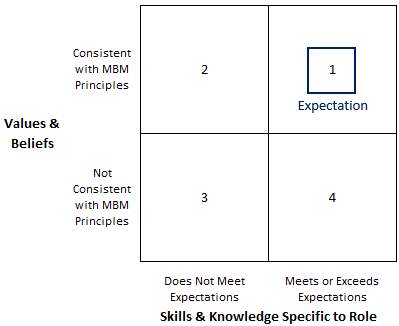
Figure X: Koch Industries Virtues & Talents Matrix
We have performance appraisals each year and we identify areas of focus. If someone is having particular issues we can provide coaching or a performance improvement plan to guide their development. Thiese however are typically used then there are problems with someones performance and can not be seen as ‘talent development’ as they focus more on correcting a probmeb rather than building a superoior level of competence.
As skills are reiqured in specific areas such as ISO13485 training and skills development is provided however these are outside the scope of the NPI process.
That being said as part of the integration process there will be the opportunity for competency development
When referring specifically to project management competence there is no formal system in place for develppment of core project management skills or additional soft skills which would benefit project managers.
What recommendations would you make in this regard?
Knowledge + Skills + Behaviours & Personality Traits & Demonstrable Performance. (Crawford 2007) There are core skills which would greatly aid a PM in successful execution of projects. These skills should be taught.
Look at soft skills too as these are benefitical for stakeholder management, negotiation, conflict resolution as PM are often at the critical interfaces.
• How are project or programme managers assigned to projects/programmes in your organisation? What recommendations would you make in this regard?
Currently these are assigned to typical project in an informa fashing. Typically this is based on a number of factors such as:
- Current workload/capacity
- Relationship with customer
- Knowledge of the subject area
- Size, scope or technical requirements of the project
- Strategic importance
For typical projects in ProTek selection is usually based on current capacity. However where projects are technically challenging or of strategic importance to the organisation we may select one of our “star players” to head up the project as they are perceived to be of higher competency level than their co-PMs.
Consider interview results. Rate on competence.
Section VII: Stakeholder Analysis
Complete a stakeholder analysis and mapping of the Senior Management Team within your organisation with respect to their likely reaction to an initiative to improve project/programme performance based on the set of recommendations you are presenting as part of this assignment.
WHAT THE ABSOLUTE FUCK?
Chapter 36 of Gowers
Include in this section a suggested stakeholder management strategy.
“The key point to remember is; don’t jeopardize future projects through poor relations now – effectively manage the project stakeholders not only to ensure success of the current project but also the future ones as well!”
SOMEWHERE:
TURNER 2007 the project manager should view stakeholder satisfaction as a key project deliverable. It should certainly be used as one of the measures of project success
TURNER 2007 Effective project management requires effective management of project stakeholders. Project managers and project sponsors need to understand the overall principles, process and techniques that should be applied if they are to ensure project success. They must also clearly define who will do what in order to ensure the appropriate level of representation, and avoid conflicting messages.
Summary Conclusion
Bibliography
Morris, P.W.G., Crawford, L., Hodgson, D., Shepherd, M.M., Thomas, J. (2006), ‘Exploring the Role of Formal Bodies of Knowledge in Defining a Profession – The Case of Project Management’, International Journal of Project Management, 24, p 710-721 DOI [Accessed … ]
Project Management Institute (2003), A guide to the project management body of knowledge (PMBOK® guide) 5th ed. Newtown Square, Pa: Author.
Project Management Institute (20017), A guide to the project management body of knowledge (PMBOK® guide) 6th ed. Newtown Square, Pa: Author.
Turner, R. (2007) Gower Handbook of Project Management 4th Edition, 4th ed, Gower Handbook of Project Management, Gower: Hampshire.
Yazici, H.J. (2009) ‘The Role of Project Management Maturity and Organizational Culture in Perceived Performance’, Project Management Journal, 40(3), 14–33. DOI 10.1002/pmj.20121 [Accessed 27 October 2017]
Zwikael, O. (2009) ‘The Relative Importance of the PMBOK® Guide’s Nine Knowledge Areas During Project Planning’, Project Management Journal, 40(4), 94–103. DOI: 10.1002/pmj.20116 [Accessed 03 October 2017]
APPENDIX
- PMBOK Knowledge Area Analysis
- PM Questionnaire
- Process Flow
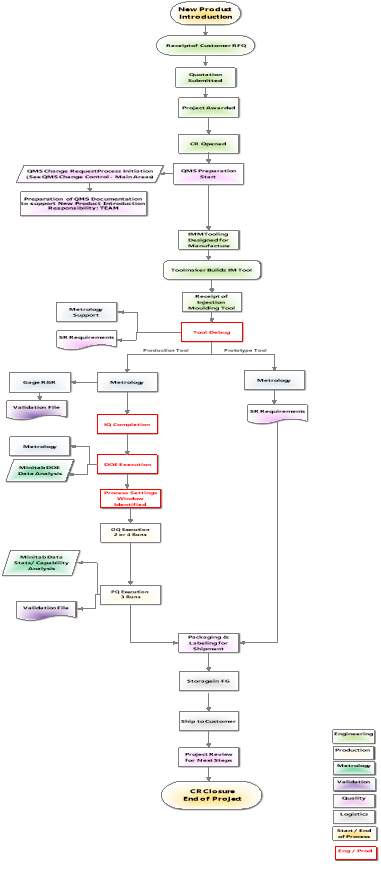
Questionnaire:
Section I: Industry and Organisational Drivers of Project Management
What are the primary items or issues which influence how you manage a project?
What are the key aspects of PM which you focus on when managing a project, wrt PM BOK KAs?
Section II: Alignment with Strategy
Are you aware of or familiar with the company strategy?
How well do you think project selection is aligned with company strategy?
What drives the selection of projects in this organisation?
What criteria, do you think, is used for project selection?
Section III: Project Lifecycle
Can you briefly describe the project lifecycle of a project here?
Section IV: Organisational Structure
Section V: Project and Organisational Maturity
Section VI: People and Competency Development
Are you aware of or familiar with any PM methodologies?
Are you familiar with the PMBOK knowledge areas?
What does the word competence mean? What is a competent PM?
Section VII: Stakeholder Analysis
- At any point during the project lifecycle do you consider who the project stakeholders are?
- How did you identify who the stakeholders are?
- How do you assess the priority of these stakeholders?
Cite This Work
To export a reference to this article please select a referencing stye below:
Related Services
View allRelated Content
All TagsContent relating to: "Business Analysis"
Business Analysis is a research discipline that looks to identify business needs and recommend solutions to problems within a business. Providing solutions to identified problems enables change management and may include changes to things such as systems, process, organisational structure etc.
Related Articles
DMCA / Removal Request
If you are the original writer of this dissertation and no longer wish to have your work published on the UKDiss.com website then please:




